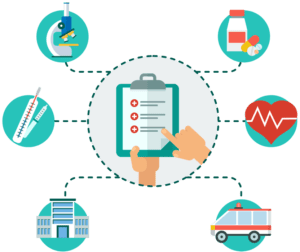Staff turnover is a concern in any industry, but it’s especially prevalent and challenging in healthcare. As a software company that serves behavioral health providers, we are familiar with the turnover challenges present in the mental health and addiction treatment space.
Working in behavioral health can be extremely demanding, stressful, and heavy. That’s a potent combination of factors that can lead to staff turnover.
In this blog post, we’ll first examine a few main causes of staff turnover in behavioral health. Then, we’ll identify how quality EHR software solutions can eliminate some of the issues that contribute to staff turnover.
Staff Burnout Leads to Staff Turnover
If you don’t recognize the term, burnout describes the process of an individual becoming frustrated and/or unhappy (burned out) in their professional role.
When an employee dislikes their position, they generally have three choices:
- Attempt to make positive changes in their current position
- Endure a negative professional experience
- Leave that position or organization
If an employee chooses that third option (or the employer chooses it for them), the organization must then fill that position. That right there is staff turnover. Put simply, it’s the process of losing talent in the workforce overtime.
Whenever an organization loses an employee, they lose a trained member of their operation. As a result, they must spend the time and resources hiring and/or training a new individual to take on that role.
Staff turnover is a reality that can’t be avoided altogether. However, organizations can make efforts to ensure that their staff’s experience won’t be the driving force behind losing talent.
Staff Burnout in Behavioral Health
There are a variety of reasons why a person can become frustrated or unhappy at their job. Each workplace, in any industry, has its own unique stressors and challenges.
Last year, we took a closer look at staff burnout in the behavioral health field. In this blog post, we’ll only be highlighting this complex issue and its connection to staff turnover.
Let’s begin with a common example: people often get into behavioral health as a direct care worker. That requires some pretty thick skin. Treating people with serious behavioral health issues isn’t always an easy spot to be in.
In speaking to some of the former behavioral health professionals on the Sigmund team, they all agree that being a direct care worker can take a mental and physical toll.
It’s a position that is demanding in a way that is difficult to completely prepare for. Romana Brigante, Sigmund’s Sales Operation Manager and licensed social worker, describes it like this: “You read about everything in a textbook and think you understand it. Then, quickly, you find out it’s nothing like reading a textbook.”
Depending on the communities an organization serves, being a direct care worker can be surprising, scary, overwhelming, exhausting; sometimes all of the above.
Behavioral health patients can be dishonest, they may break the rules. In more serious cases they may self-harm or become violent with others. A direct care worker may deal with all of those scenarios and more in a single day.
The work itself can be very difficult right from the beginning. If behavioral health professionals consistently work in hectic, high-stress environments, it can have very real mental, emotional, and physical implications.
It’s not uncommon for a direct care worker to burn out in such a position after a few years and quit, thus creating a turnover issue for the organization.
Protecting Against Burnout and Preventing Staff Turnover
What can providers do to protect their staff from burnout and their organization from turnover?
There are many answers to that question, but compassionate leadership and support are two factors at the very top of that list.
We’ve found that if an organization is driven by a genuine desire to help their patients, they generally have a good support system in place for their staff.
One way to best serve the patient is by employing a staff that feels empowered and supported to do their best work. Both patients and staff, and thus the organization, benefit from it.
Unfortunately, there are some providers out there that are primarily motivated by money. These organizations tend to treat patients as revenue opportunities rather than humans who need support.
In these cases, it’s not uncommon for staff to be left unsupported and even exploited. This type of environment is virtually guaranteed to breed staff frustration and burnout.

Sigmund has been lucky enough to work with a variety of organizations that extend compassion and support to their staff. We can attest that this leadership approach plays a big role in their overall success as treatment providers.
Working in the behavioral health space, you get to meet all kinds of people that are passionate about helping those facing mental health and addiction issues. It’s one of the best things about our job.
And, if you ask us, it’s also one of the reasons that we see so much compassionate leadership across the industry. Sometimes, the person running a treatment facility, or the clinician leading a group session, has been through that same treatment themselves.
When those providing treatment have been in the patients’ shoes, it can promote empathy and understanding in how an organization operates across the board. That includes the empathy and understanding offered to staff, which is so important if you want to retain talented employees.
EHR Software That Prevents Staff Turnover
Of course, it takes more than strong leadership to run a successful operation, in terms of care delivery and staff morale.
A crucial aspect for success in both areas is a modern EHR software solution. In 2021, dynamic software designed for behavioral health is an absolute necessity for the communities we serve.
We’ve covered the many ways that powerful EHR solutions enhance the delivery of behavioral health in great detail. For the purposes of this blog post, we’re going to examine some software features that help keep staff happy and retained.
EHR Software Workflows
Workflows are a fundamental aspect of any modern EHR. We describe them as the nervous system of your software because they’re always working in the background, automating core functions.
Workflows drive all the intelligent automation in an EHR platform, from auto-populating data in documentation to generating decision support for users.
Virtually any feature powered by the workflow engine stands to help users do their job. In the context of this blog post, that means workflows generally ward off burnout and turnover.
One automation that’s particularly important for staff support is golden thread functionality. That’s a fancy way of saying that a patient’s information automatically follows them wherever they go in the system.
As a result, the data in a patient’s chart updates in real-time so that all users are working with the most current treatment information. As soon as a change is made by one user, it immediately generates for the entire staff to see.
It may seem like a simple feature, but this automation makes a huge difference. A staff’s life is made much easier when they don’t have to go searching for new information or enter data multiple times.
EHR Communication Tools
Behavioral health treatment often spans multiple levels of care. Communication between staff working in different departments or programs is critical.
Consider the relationship between the residential staff and clinical staff at a behavioral health treatment center.
A residential team has daily contact with patients while clinicians follow a more intermittent schedule. The people making sure patients are safe, fed, and accounted for seven days a week need to understand a clinician’s treatment goals so they can support those efforts day by day, or encounter by encounter.
And, conversely, the clinician needs the residential staff to provide context as to how a patient is faring every day, how they’re responding or not responding to a given treatment approach.
They deliver two different types of care, but must be on the same page so that patients receive comprehensive treatment. If they’re not on the same page, disconnected care from both sides often does the patient more harm than good.
Furthermore, a disconnect between two staff groups can create a negative professional environment, in terms of both job performance and interpersonal communication. The most effective software contains tools that ensure the exchange of information between staff is as smooth and automated as possible.
An EHR serves as the perfect hub for staff to exchange critical treatment information.
For example, most systems contain patient chart and progress note functionality. Both types of documentation contain lots of relevant patient data.
If the EHR updates these records in real-time, it can often eliminate the need for direct staff communication. They may be able to find the mission critical information they need right in the most recent progress note.
Dynamic EHRs promote this kind of passive communication, where information is exchanged without users having to stop and speak to each other.
A shift notes feature also contributes to easy communication in a similar way. Progress notes are used to report on what transpired in a single encounter, like a therapy session, and are therefore mostly written by clinicians. Shift notes are a place for other staff to record more general context about a patient and their condition.
Patient care is a 24/7 job. It’s impossible to anticipate when important treatment developments will take place. Shift notes are commonly used by the residential, nursing, or overnight staff to record any relevant updates or context from their shift.
As a result, it’s easy for everyone, no matter their role, to pass along information that will help their coworkers. A few clarifying sentences in a shift note from the overnight staff could be the difference between a positive outcome and a less positive one.

A more direct EHR communication tool is instant messaging.
Most modern EHRs contain instant messaging tools so that staff can get in touch with each other immediately if necessary. Whether it’s a quick update or an emergency, the ability to talk to any other user at a moment’s notice is often very useful.
These communication tools promote collaboration and synergy across an entire operation. They empower staff to rely on each other in an efficient and effective manner, thus promoting teamwork between different departments.
If users feel supported by the coworkers in their department and in other departments, it goes a long way to their overall morale. That’s the kind of environment we see behavioral health professionals thrive in.
We’ve been working in this industry for two decades so we know there’s plenty of chances for miscommunication in the hectic clinical setting.
We’ve seen how breakdowns in communication can cause a disconnect between a residential staff and a clinical staff. Unfortunately, that can breed distrust between departments and frustration on an individual level. Not only does that negatively impact patient care, it can create an environment that staff do not want to work in.
Organizations need software tools that mitigate those risks, or eliminate them altogether.
Keeping Your Staff in Mind
Does your software solution support and empower your staff in these ways?
On a professional level, users benefit from using an EHR that’s designed to facilitate their efforts.
Now more than ever, though, it’s important to consider your staff on a personal level as well. Providers need to be thinking about the wellbeing of their team now that COVID-19 has imposed a variety of new challenges on an already overburdened behavioral health workforce.
Under normal circumstances, the mental hardships of being a direct care worker would be offset by the life they had in their personal life. However, COVID-19 has blanketed our personal lives with stress, pain, loss, confusion – the list goes on and on.
Providers must be cognizant of and empathetic to this fact. We’ve seen our clients extend great understanding and compassion to their staff throughout the pandemic. From what we’ve seen, that’s virtually a requirement of delivering excellent care during this time.
To get a better idea of the impact COVID-19 has had on our collective state of mind, check out this blog post about pandemic stress. It’s important information to have when considering your staff’s responsibilities, performance, and wellbeing.


